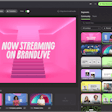![Hd Gameplay Ff[1][1]](https://img.bizbash.com/files/base/bizbash/bzb/image/2021/04/HD_GAMEPLAY_FF_1__1_.607dd143b9766.png?auto=format%2Ccompress&q=70&w=400)
So, you can't find the right platform for the virtual event of your dreams. Why not build your own?
That’s the approach Brad Nierenberg took for the 16th annual Chance for Life benefit, which took place Feb. 27. When it became clear that his annual 2,000-person poker tournament fundraiser couldn’t take place in person due to COVID-19, the Alexandria, Va.-based entrepreneur—who is the president and CEO of experiential marketing agency RedPeg as well as the founder of the Chance for Life charity—decided to launch Poker 501, a new non-gambling poker platform geared toward charitable events.
Nierenberg leaned on his experiential background when he founded Chance for Life 15 years ago, after his best friend’s daughter was diagnosed with cancer. “I wanted to create an experience for people, and I believed that sitting at a poker table is an effective social engagement experience,” he explained. “Competition breeds conversation, even with people you don't know, so the poker table was my starting point.”
From there, the benefit has grown tremendously; in early 2020, the in-person event drew 850 poker players and raised $2.9 million during a 13-hour event that comprised a tournament followed by a massive, Las Vegas-inspired party with surprise guests like Robin Thicke, Daya and Blues Traveler.
When planning for 2021’s virtual event, Nierenberg discovered that most online poker platforms were geared toward individual players, rather than a group experience. “Why do we do events? Because of the one-on-one interaction,” he noted. “Create an experience that everybody wants to be a part of, and the value of your experience is going to go up dramatically.”
Six months ago, Nierenberg decided to launch Poker 501, which he refers to as an “engagement platform” that’s specifically aimed toward events and charitable experiences. Working with a developer who had a baseline idea for a single-table game, the team created a platform that allows audio and video integration, meaning players can interact just like they would at a live game—no second screen or third-party app needed. Poker 501 also has the ability to do a presentation and videos, typically crucial components of a nonprofit event. An added bonus? At the end of the night when the tournament gets down to the final table, all virtual attendees are able to tune in and watch the grand finale.
CFL - 2020 POKER 501 DEMO - v3 from RedPeg Marketing on Vimeo.
For Chance for Life’s 2021 benefit, 480 players were randomly broken into groups of eight people. Players were moved to different tables throughout the night, “which created an energy and excitement about it, some surprise and delight,” Nierenberg explained. “You never knew who you're going to sit next to and network with—and when you're playing poker, it doesn't matter if you make $1 million a year or you make $50,000; you all have the same amount of money on the table. You're all playing at the same level, and it breaks down the barriers.”
To create an even more immersive experience for attendees, the team offered a meal delivery service featuring a variety of up-and-coming local chefs. “We had seven chefs curate an experience of different courses,” Nierenberg said. “And I had four top mixologists in the city create premade cocktails that went along with the different meals.”
The benefit ultimately raised $1.5 million for Chance for Life—and Nierenberg says that without the costs of a venue, travel and other in-person expenses, he actually ended up raising more money for the nonprofit than in previous years. He believes that future Chance for Life benefits will certainly incorporate a virtual component.
“We were always a Washington, D.C.-based event, and we had only 850 people who could participate. [With virtual,] my sponsors are saying, ‘We should do this once a quarter,’’ he said. “I can invite people that could never fly in. It allows us to generate more money and be relevant for a longer period of time.”
To pay it forward, Nierenberg has started offering Poker 501 to other charities; he says that four other nonprofits, along with a mix of corporations, are currently using the platform. Plus, a portion of all proceeds from those events goes to Chance for Life.
To nonprofits that aren’t sure how to host virtual or hybrid benefits right now, Nierenberg advises them to first identify their core essence or message. “Then you can create the experience around that core,” he noted. “Focus on creating an experience and creating engagement, and that will carry you forward with your sponsors and with raising the money and awareness that you need.”
The key is to get people excited about your cause, in whatever way makes sense to you. “If you focus on creating an experience and engagement, you're sledding downhill as opposed to rolling uphill,” he said. As for the virtual world, “Technology is a great enabler of engagement if you focus on two-way dialogue, not one-way dialogue. Poker is just my example."
This story originally appeared on BizBash's parent site, connectmeetings.com, here.



















